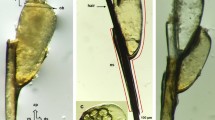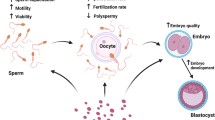Summary
The origin of periderm and epidermis has been studied in trout embryos from stage 20 (2 days after fertilization at 10° C) to hatching (stage 410).
Between stages 20 and 50, the blastodisc consists of an inner mass of blastomeres covered by a superficial layer of closely packed blastomeres, the peripheral layer. This layer gives rise to both peripheral cells and to cells joining the inner mass of blastomeres.
Between stages 50 and 110, junctions differentiate between peripheral cells. This newly formed superficial epithelium, the enveloping layer, no longer gives rise to inward migrating cells.
From stage 110 on, a basement membrane differentiates beneath a one-cell thick subperipheral layer, which thus becomes the ectodermal basal layer, the prospective epidermal basal layer.
From these and ultrastructural observations, it is concluded that 1) the epidermis apparently originates, at least in part, from the peripheral cells, between stages 20 and 50; 2) the periderm assumes a protective function over the body of the embryo and also a secretory function over the yolk sac (probably producing the hatching enzymes); 3) the periderm, which is a temporary structure, appears to play the role of an embryonic membrane in teleosts.
Résumé
L'origine du péridermet de l'épiderme a été étudiée chez l'embryon de truite du stade 20 (2 jours après la fécondation, à 10° C) à l'éclosion (stade 410).
Entre les stades 20 et 50, le blastodisque de truite est composé d'un massif de blastomeres recouvert par une couche de blastomeres serrés les uns contre les autres appelée la couche périphérique. Cette couche périphérique donne naissance à des cellules qui restent dans cette couche mais aussi à des cellules qui rejoignent le massif de blastomères internes.
Entre les stades 50 et 110, les cellules de la couche superficielle contractent entre elles des liaisons de plus en plus étroites (zonulae adhaerentes) et ne donnent plus naissance à des cellules qui migrent en profondeur. On désigne cette formation sous le terme de couche enveloppante.
A partir du stade 110, une lame basale existe au-dessous de la couche de cellules située immédiatement au-dessous de la couche périphérique. A partir de ce stade on peut désigner par périderme et épiderme ces deux couches. L'ensemble de ces observations permet d'aboutir aux conclusions suivantes:
L'épiderme pourrait tirer son origine des cellules périphériques, entre les stades 20 et 50.
Le périderme a une fonction protectrice au niveau du corps de l'embryon mais également une fonction sécrétrice au niveau de la vésicule vitelline (produisant les enzymes de l'éclosion).
Enfin le périderme, formation temporaire, apparaît comme une véritable annexe embryonnaire, propre aux Téléostéens.
Similar content being viewed by others
References
Ballard, W.W.: The role of cellular envelope in the morphogenetic movements of teleost embryos. J. exp. Zool. 161, 193–200 (1966)
Ballard, W.W.: A re-examination of gastrulation in teleosts. Rev. Roum. Biol. Zool. 18, 2, 119–135 (1973)
Bouvet, J.: Histogenèse précoce et morphogenèse du squelette cartilagineux des ceintures primaires et des nageoires paires chez la truite (Salmo trutta fario L.). Arch. Anat. micr. Morph. exp. 57, 35–51 (1968)
Bouvet, J.: Différenciation et ultrastructure du squelette distal de la nageoire pectorale chez la truite indigène (Salmo trutta fario L.). I. Différenciation et ultrastructure des actinotriches. Arch. Anat. micr. Morph. exp. 63, 1, 79–96 (1974)
Brown, G.A., Wellings, S.R.: Electron microscopy of the skin of the teleost, Hippoglossoïdes elassodon. Z. Zellforsch. 103, 149–169 (1970)
Damas, H., Firket, H.: Contribution à l'étude de l'ultrastructure de l'épiderme de lamproie. Ann. Soc. roy. Belg. 96, 1, 48–59 (1966)
Devillers, Ch.: Le cortex de l'oeuf de truite. Ann. Stat. Centr. Hydrobiol. appli. 2, 229–249 (1948)
Devillers, Ch.: Les mouvements superficiels dans la gastrulation des poissons. Arch. Anat. micr. Morph. exp. 40, 298–309 (1951)
Devillers, Ch.: Structural and dynamic aspects of the development of the teleostean egg. Advanc. Morphogenes. 1, 379–428 (1961)
Devillers, Ch., Colas, J., Richard, L.: Différenciation in vitro de blastodermes de truite (Salmo irideus) dépourvus de couche enveloppante. J. Embryol. exp. Morph. 5, 264–273 (1957)
Downing, S.W., Novales, R.R.: The fine structure of lamprey epidermis. I. Introduction and mucous cells. J. Ultrastruct. Res. 35, 282–294 (1971)
Downing, S.W., Novales, R.R.: The fine structure of lamprey epidermis. II. Club cells. J. Ultrastr. Res. 35, 295–303 (1971)
Downing, S.W., Novales, R.R.: The fine structure of lamprey epidermis. III. Granular cells. J. Ultrastruct. Res. 35, 304–313 (1971)
Farquhar, M.G., Palade, G.E.: Junctional complexes in various epithelia. J. Cell Biol. 17, 375–412 (1963)
Fishelson, L.: Histology and ultrastructure of the skin of Lepadichthys lineatus (Gobiesocidae, teleostei). Mar. Biol. 17, 4, 357–364 (1972)
Goette, G.: Ueber die Entwicklung des Central-Nerven-Systems der Teleostier. Arch. f. mikr. Anat. 15, (1878)
Harris, J.E., Hunt, J.: The fine structure of the epidermis of two species of salmonid fish, the Atlantic salmon (Salmo salar L.) and the brown trout (Salmo trutta L.). I. General organization and filament-containing cells. Cell Tiss. Res. 157, 553–565 (1975)
Hawkes, J.W.: The structure of fish skin. I. General organization. Cell Tiss. Res. 149, 147–158 (1974)
Hay, D.E.: Organization and fine structure of epithelium and mesenchyme in the developing chick embryo. In Epith. mes. interactions (Fleischmajer and Billingham, eds.), pp. 34–55. Baltimore: The W. & Wilkins Comp. 1968
Henneguy, L.F.: Recherches sur le développement des Poissons osseux. Embryogénie de la truite. J. Anat. (Paris) 24 (1888)
Henrikson, R.C., Matoltsy, A.G.: The fine structure of teleost epidermis. I. Introduction and filamentcontaining cells. J. Ultrastruct. Res. 21, 194–212 (1967)
Henrikson, R.C., Matoltsy, A.G.: The fine structure of teleost epidermis. II. Mucous cells. J. Ultrastruct. Res. 21, 213–221 (1967)
Henrikson, R.C., Matoltsy, A.G.: The fine structure of teleost epidermis. III. Club cells and other cell types. J. Ultrastruct. Res. 21, 222–232 (1967)
Jimbo, G., Shibukawa, T., Kobayashi, K., Kimura, K.: Electron microscopic observation on epidermis of teleost, Salmo irideus. Bull. Yamaguchi med. School 10, 49–52 (1963)
Jurand, A.: Ultrastructural aspects of early development of the fore-limb buds in the chick and the mouse. Proc. roy. Soc. B 162, 387–405 (1965)
Lentz, T.L., Trinkaus, J.P.: Differentiation of the Junctional complex of surface cells in the developing Fundulus blastoderm. J. Cell Biol. 48, 455–472 (1971)
Massari, S.T.: Il differenziamento dell'epidermide nello sviluppo di Salmo irideus Gibb. Arch. ital. Anat. Embriol. 76, 19–32 (1971)
Merrilees, M.J.: Epidermal fine structure of the teleost, Esox americanus (Esocidae, Salmoniform). J. Ultrastruct. Res., 47, 272–283 (1974)
Mittal, A.K., Datta Munshi, J.S.: Structure of the integument of a fresh-water teleost, Bagarius bagarius Ham. (Sisoridae, Pisces). J. Morph. 130, 3–10 (1970)
Pasteels, J.: Etudes sur la gastrulation des vertébrés méroblastiques. I. Téléostéens. Arch. Biol. (Liège) 47, 205–308 (1936)
Sengel, P., Rusaöuen, M.: Modifications ultrastructurales de l'histogenèse de la peau chez l'embryon de poulet. Arch. Anat. micr. Morph. exp. 58, 77–96 (1969)
Steopoe, I., Nedelea, M.: Comportement de la couche enveloppante (Deckschicht) dans l'embryogenèse et la structure du tégument chez l'embryon, la larve et l'alevin de Cyprinus carpio L. Anat. Anz. 121, 93–102 (1967)
Trinkhaus, J.P.: The significance of the periblast in epiboly of the Fundulus egg. Biol. Bull. 97, 249–254 (1949)
Trinkhaus, J.P.: A study of the mechanism of epiboly in the egg of Fundulus. J. exp. Zool. 118, 296–319 (1951)
Trinkhaus, J.P., Lentz, T.L.: Surface specializations of Fundulus cells and their relation to cell movements during gastrulation. J. Cell Biol. 32, 139–154 (1967)
Wellings, S.R., Brown, G.A.: Larval skin of the flathead sole, Hippoglossoïdes elassodon. Z. Zellforsch. 100, 167–173 (1969)
Whitear, M.: The skin surface of bony fishes. J. Zool. Lond. 160, 437–454 (1970)
Witschi, E.: Development of vertebrates. Philadelphia-London: W.B. Saunders Comp. 1956
Author information
Authors and Affiliations
Additional information
I am very grateful to Professor Ph. Sengel for critical reading of the manuscript and for linguistic assistance.
Rights and permissions
About this article
Cite this article
Bouvet, J. Enveloping layer and periderm of the trout embryo (Salmo trutta fario L.). Cell Tissue Res. 170, 367–382 (1976). https://doi.org/10.1007/BF00219418
Received:
Revised:
Issue Date:
DOI: https://doi.org/10.1007/BF00219418




